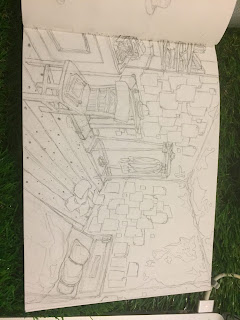We started by setting up the two lights we had, around the set from different angles. We played around with the gels (blue, orange, yellow) that we had until we had lighting that matched Daisy’s background plans. We also had two different lenses (macro and a zoom lens) to experiment with, which effected the set, such as elongating rooms or making them look narrower. For some shots, the edges of the set were visible so I built a ceiling to go on top, but angled in such a way that it would not block out the light sources. We experimented like this until we found the best lighting and lens settings for every room.
The first animation test involved one of the doors swinging open. The effect of the blue and piercing orange gel light gave a very nice contrast to the film. The shadows created here will also be very important. From this test, we’ve decided to incorporate a scene where the main character’s shadow is projected onto the wall by the orange light, when the protagonist walks into the secondary character’s room, with focus only on the shadow. The only thing I'd change about this scene is make the door open much slower, by taking photos of it 'on twos'.
The next test involved a scene where the hands of the wall people spring out of the fireplace. I was very pleased with how this went - the hands appeared to have a lot of weight to them and we found focusing on anticipation and 'easy ease' spacing the most useful principals for this element. The only thing I'd critique with this scene was one of the finger's movements were unnatural in places but you have to look out for it to notice it. This will be the most intricate scene in the animation - the 5 seconds of footage here took 2 hours to make.
What Went Well
- The outcome of the tests matched the background plans very closely
- The tests develop on from the animatic stage, where shots that we thought looked good in the testing stage, will be inserted into the animation
- The tests have been very useful for finding problems early on, which we can avoid for the real thing, such as finding a way of stabilising the hands but also allowing them to slide forward - I got around this by building a vice contraption.
Criticism
- One lens accentuated the height difference between the main and secondary character too much, so we had to adjust the camera angle and lens for the corridor confrontation scene
- We jogged the camera slightly in some of the tests, but know next time not to have the camera on the carpet when we're taking photos
- The tests have weakened the puppets a bit, however they have been necessary tests as it has given us a feel for how they animate



















































